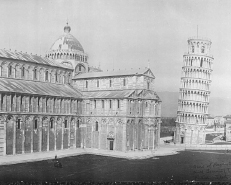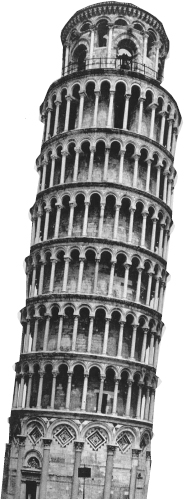How an Islamic invasion led to one of the world’s wonders.

An army of Arabs, Berbers, and Spanish Moors invaded Sicily in 832. They were known to Europeans as the Saracens. Within fifty years they had taken over most of the island, and they ruled it in the name of Islam for two centuries.
In 1004 the Saracens sacked the Italian city-state of Pisa. The citizens there thought of themselves as traders, not fighters, but in response to Saracen attacks they built up a navy to defend themselves. Then they turned the tables on their one-time invaders, undertaking a daring raid on Palermo, the capital of Saracen Sicily. They ravaged the city, sinking many Saracen ships. Only one enemy vessel remained afloat, and it was used to bring back a shipload of plunder.
Back home, the powers that be decided that a portion of the booty should be used to fund the construction of a grand cathedral, which was duly built. A cathedral wouldn’t be complete without a bell tower, and in 1172 a wealthy widow named Berta Di Bernardo left “sixty coins” in her will for the construction of one. Work began immediately but kept getting interrupted by battles with Florence and other Italian city-states. It took almost two centuries to finish it.
Maybe that’s where the problem began. Or maybe it would have happened anyway, what with the structure’s shallow foundation and shifting subsoil. For of course the cathedral bell tower that the Pisans built had a flaw. A flaw that would one day be seen as it’s greatest glory, and make it known around the world.
From an Islamic invasion and a widow’s will: the Leaning Tower of Pisa.

In the summer of 1944, the fate of the tower was in the hands of U.S. Army sergeant Leon Weckstein. The Germans were thought to be using the tower as an observation post. Weckstein was sent forward with orders to call in an artillery barrage if he saw any movement in it. “Had I seen the glitter of one shiny button, even for a second, the tower would have become a pile of gravel,” he said later. Seeing nothing suspicious, however, Weckstein held off giving the order for the tower’s destruction. Eventually, Allied generals decided to spare the landmark.

The tower wasn’t even finished in 1298 when the first commission was formed to look into its stability. Seventeen such commissions have been formed over the centuries, some helping, some hurting. Scientists believe that the most recent commission’s efforts have stabilized the tower for the next few hundred years.